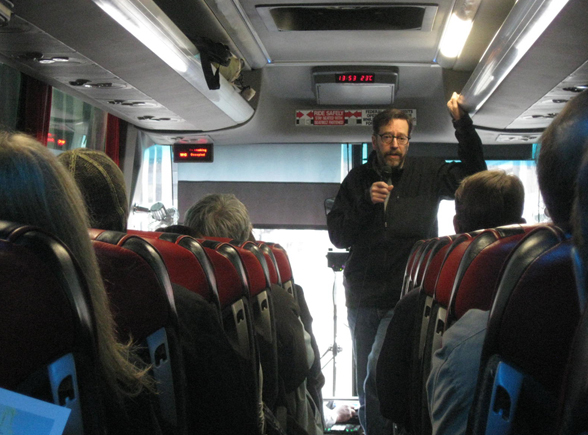
Article provided by the American Planning Association | April 13th, 2013 | Photo Credit: APA
Photo Caption: Lee Brown, FAICP, AICP Commission President-Elect, briefed planners on the bus headed for Saturday’s Community Assistance Program workshop in Chicago’s East Garfield Park neighborhood.
The bus pulled out of the Hyatt as Saturday morning snow began to fall, and over 20 planners set out westward towards East Garfield Park for the AICP Community Planning Workshop.
The bus took the group past Chicago landmarks like the United Center Arena and into the neighborhood of East Garfield Park. The group rode by the Burnham–planned boulevards and Olmsted–designed parks, ending in a neighborhood where many artists have been living for decades.
The former industrial area and workforce housing neighborhood is attractive to artists because of the low cost of living. Many large facilities and government buildings are either vacant or underused. The group then arrived at the Legler Library on Garfield Park to convene with community members.
Julie Burros, from the Department of Cultural Affairs, presented the recent Chicago Cultural Plan to the group, explaining the process and outputs to see how the city is able to create development around culture, and not simple overlaying districts. The plan looks to expand the concept of cultural development to have levels of public and private investment.
Jim Cocks, AICP, of the City of Chicago Department of Housing and Economic Development presented the city’s plans to protect business and industrial uses in Chicago. His agency is using various incentives and protecting zoning to keep these vital aspects of the city’s economy in Chicago.
The final presentation was from Mike Thomas from the Garfield Park Community Council, which is a local community development organization. He spoke to the tactics used and projects implemented to engage the community to address issues in the area and promote inclusive development.
The group of planners and community members then counted off into four breakout groups. The first session was to look how the Cultural Plan can come to East Garfield Park. They identified stakeholders and key champions who should be involved in the process to move towards a cultural plan in the neighborhood. They also were charged to create a vision for the arts district in East Garfield Park.
The groups continued working through lunch, which was delivered by Inspiration Kitchens. The restaurant is linked to the Inspiration Corporation, which provides programs like job training and other poverty alleviation programs in Chicago. Inspiration Kitchens in located in East Garfield Park and has a restaurant skills training program as well.
After lunch, the entire group came together to share the results from the first breakout group. Themes that came up were based on broadening the idea of what art and culture can be. It is important to identify and capitalize on existing artists’ networks, but also bringing art to everyone in the community.
Vacant spaces and buildings were also highlighted as a great opportunity for new uses for artists and other community members. The red tape associated with reusing these spaces is complicated and needs streamlining and tends to favor real estate developers to buy the land only. The community needs to galvanize existing institutions and neighborhood associations to reinforce their importance and spur conversations among various stakeholders.
There is a lack of city support for physical and virtual space to gain access to markets for artists; and there were ideas to build market places with a link to educational programming. Evaluating metrics would be helpful to show potential funders that programs and projects are having a positive effect on the neighborhood.
There is a need to support ex-cons in the area, as there is a large influx in East Garfield Park, but no services for them once they arrive. Local residents should be involved with the conception, creation, and maintenance of public art to take ownership; beautifying transportation infrastructure and painting murals were suggested as ideas.
The participants then went back to their groups to think of ways to make the arts community and also make it sustainable. The groups came back with many ideas first of which was that the neighborhood needs to organize the artists in either a formalized group. This organization can also be virtual through a website and social media in order to communicate more efficiently and stimulate more activity. The groups were able to identify the economic benefit of arts, which should be communicated to politicians, which is easy to back politically.
The Federal Livable Communities Program was mentioned as a possible funding source for community development. Planning interns could aide in the conception of building a community organization and other planning activities before a formal organization arises.
The day ended with discussing what to do next. The next steps should address how to reach consensus, with one group proposing a next meeting in May, but with the assistance of a third party facilitator. The artists realize they must bring in those people with certain skills to be able to work towards a productive future. They are reaching out to local planners and others that would like to continue to work with the community moving forward.
The engaging discussion through the day laid out a plan for the future of the neighborhood to embrace the artist community and also develop and move forward.
